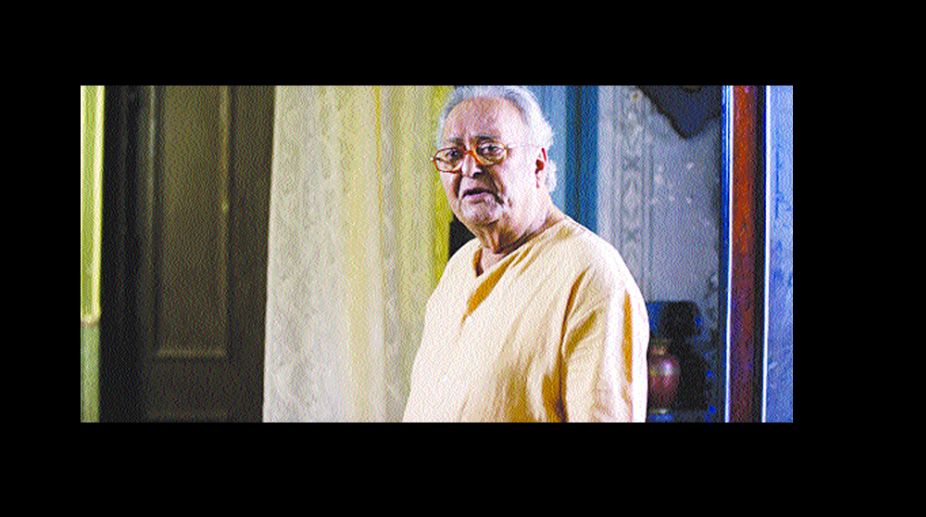Down the celluloid lane of two Bengali icons
The Statesman gets an insider’s view into an author’s mind.

Soumitra Chatterjee
Confronted with a string of inanities, the viewer can only be relieved when a film leaves a sensible impression and is handled with a measure of competence. Most Bengali films that are now offered raise some curiosity about the credentials of their makers. There are no regrets when many of these productions sink or don’t manage to reach the theatres or multiplexes. They were misconceived to begin with. But there are mild surprises like 61 Garpar Lane in the sense that there has been some thinking done about the subject and a definite purpose behind the effort.
The film based on the future of old mansions in Kolkata may well be seen as digging up stock emotions and talking about disappearing life patterns in a rapidly changing city. But somewhere in the familiar picture of a crumbling reality in an old part of Kolkata that witnesses the contradictory waves of sorrow and survival, despair and dreams, there emerges a sense of nostalgia that makes it more meaningful than other films in the same category.
The crew, it would seem, consists mainly of first-timers but the cast is quite strong. But the inclusion of seasoned performers wouldn’t have mattered had the fundamentals been weak. That is what distinguishes this effort that revolves the uncertain future of families crammed in a dilapidated building that cries out for some kind of attention if it has to be preserved. The social climate points in the reverse direction. Old buildings are being torn down to make way for malls, multiplexes and high-rises. The trend that began many years ago in the south of the city where space was available or could be negotiated with some resourcefulness has now penetrated the old localities in the north which have a different complexion. The makers of the film have apparently studied the realities in some detail and have come up with a credible screenplay. It is steeped in the hassles that have become part of the lives of families in that address. But it is also sustained by human touches that make the people want to share each other’s suffering.
Advertisement
The desperate effort by developers to grab the old structures that would bring them a windfall has been turned into a cliché on the screen. This could well have gone in the same direction had it not been for a conscious effort to change the focus. The film with its restrained tone and treatment extends the subject to several related issues. The old landlord, played with conviction as usual by Soumitra Chatterjee, is a bundle of mixed emotions that remain faithful to ground realities. He cannot survive on the meagre rents that he collects from the motley group of quarrelling tenants with whom he has struck a bond that compensates for the emotional distance with his own kin. Apart from another source of livelihood, the house not only holds memories but, more important, the means of survival in a climate of warmth, caring and togetherness — from the child with whom he spends some wonderful moments to others he helps in their distress. Through all this, the film cannot follow a linear structure but each character or family seems to become an integral part of a cultural identity that is threatened by the new realities. The cameos are strung together with conviction largely because of the competent cast. Manoj Mitra, Kharaj Mukherjee and Chitra Sen resemble a breed of tenants who have survived the inconveniences of their daily rituals and have acquired the warmth of living together. There are touches of painful reality that are not blown out of proportion. Nor are there concessions to popular taste.
That doesn’t mean that the film can resist the power of wish-fulfilment. The emotional drama takes predictable turns when the landlord’s kin arrives to negotiate on behalf of the developer. While the tensions are examined with a clear leaning towards popular expectations, the script looks at individuals with diverse connections and interests who contribute to the overall structure. Somehow the film looks compact and convincing even though the final outcome — pleasing as it appears to all the inhabitants — would seem to have been contrived. That people change in tune with the mood of the film has long been a cliché. The difference here is that the experience is pleasing with a theme song that sustains the tone.
61 Garpar Lane is not likely to be remembered as something that marks a departure from convention. But it offers a sense of nostalgia that is quite touching. The interiors of the mansion are quite real and the incidents, disjointed as they are, flow into one another to make it a gentle web of happy memories.
The film also has a modest look and revives old-fashioned drama with the difference that it also seeks to make a statement with a contemporary relevance. The fact that the screenplay is original and the treatment is assured and sensitive enough to suggest that the team has a future with projects that may not always aim too high.
Advertisement